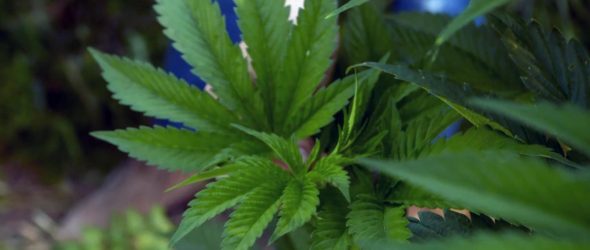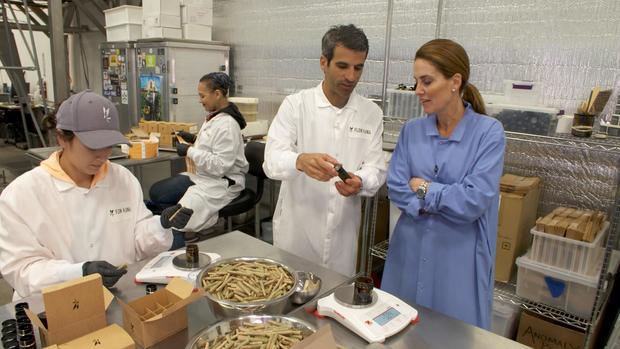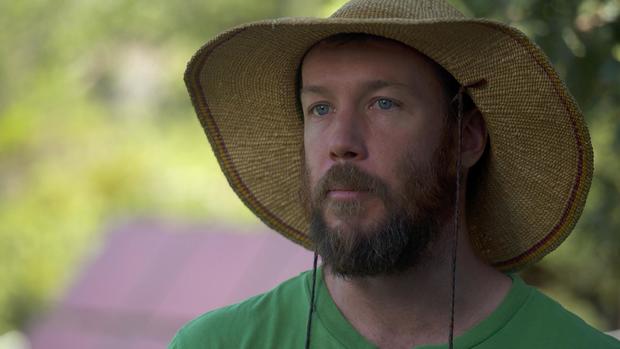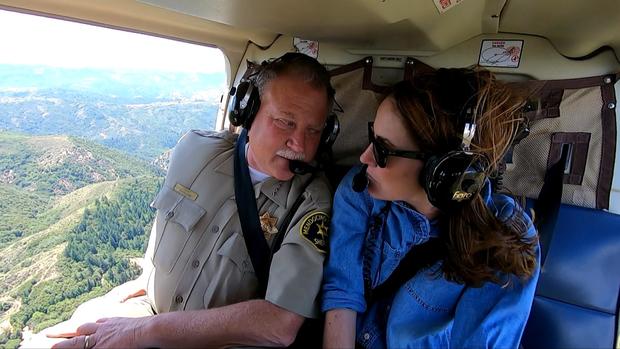It’s getting close to harvest season for one of California’s largest cash crops – marijuana. Valued at more than $11 billion, it’s worth more than the state’s grape and almond industries combined. California grows more pot than any place in the country.
Nearly four years ago, voters approved a ballot measure called Prop 64 in California. It made marijuana legal for anyone over the age of 21.
Advocates said a regulated pot industry would push out the black market and generate more than a half billion dollars a year for the state.
As we first reported in October, it’s not quite worked out that way.
We spent a week in a region of California that should be rolling in profits, the Emerald Triangle. What Napa is to wine, the triangle is to weed. It’s Mediterranean climate and rich soil are famous for producing some of the highest quality marijuana in the world.
This might look like a Home Depot, but it’s a pot processing plant and every one of those buckets is full of marijuana. At the height of production, this room is the biggest legal pot stash in the country.
Sharyn Alfonsi: How much cannabis is in this room?
Mikey Steinmetz: There’re several thousand pounds.
Sharyn Alfonsi: Several thousand (LAUGH) pounds?
Mikey Steinmetz: Yes, tens of thousands, actually.
Sharyn Alfonsi: Wow, okay.
Mikey Steinmetz runs the Flow Kana Factory. It packages weed from legal state-regulated farms in the emerald triangle to be shipped and sold around California to licensed stores. There is nothing like this anywhere else in the pot industry.
Sharyn Alfonsi: This is like Willy Wonka stuff, right?
Mikey Steinmetz: Yeah. We– we’ve been called that before, the Willy Wonka of weed.
Sharyn Alfonsi: So did you co– have to create and come up with all this stuff?
Mikey Steinmetz: Everything– everything. And that– that’s what the hardest part is that, like, the technology and innovation is just starting to enter this space.
Forget those stereotypes about stoners, some of his workers came from Apple and Google. They precisely weigh joints, inspect buds like gems and package it to look more like high end cosmetics than cannabis.
Sharyn Alfonsi: Oh wow.
Mikey Steinmetz: It’s the different– this is Pineapple Wonder. Does it smell pineappley?
Sharyn Alfonsi: Yeah, yeah.
Steinmetz raised $175 million in just one year to get this off the ground, but despite all that, all along the supply chain we found its been far from a gold rush.
Sharyn Alfonsi: Is it a windfall? Are you all of a sudden rich?
Mikey Steinmetz: (LAUGHS)
Sharyn Alfonsi: Are you making tons a profit?
Mikey Steinmetz: No. Candidly, like– the regulated market has been a fraction of what everybody expected it to be.
Sharyn Alfonsi: Why?
Mikey Steinmetz: You know, the retail market has been very slow to roll out.
The slow roll out is because of the strict limits on opening pot shops in California. Although Prop 64 legalized marijuana across the state, it gave towns and cities the power to decide if pot businesses can open locally. 80% said not in my town.
Mikey Steinmetz: So we have less retailers than we do in Oregon, for example, in a state that has, you know, orders of magnitude larger.
Sharyn Alfonsi: Say that again. You have less retailers…
Mikey Steinmetz: There’s less retailers in California than there are in the State of Oregon.
And remember, California growers can only legally sell their marijuana in California. And licensed stores like this one in the emerald triangle are rare.
Sharyn Alfonsi: Give me a sense of kind of who the customers are who are walking in right now.
Emerald Pharms Cannabis Retail Store Manager: Our demographic is over 60. That is–
Sharyn Alfonsi: Really?
Emerald Pharms Cannabis Retail Store Manager: Yes, yeah. We get–
Sharyn Alfonsi: Are they old hippies or are they grandparents with joint pain?
Emerald Pharms Cannabis Retail Store Manager: I would say they’re (LAUGH) both.
But there’s not enough stores like this that sell marijuana legally and there’s way too much of it being grown. California grows 11 million more pounds than it can consume a year. Prices have crashed and made things even more difficult for legal businesses like Flow Kana.
Sharyn Alfonsi: There’s an insane surplus–
Mikey Steinmetz: Yeah.
Sharyn Alfonsi: –of marijuana.
Mikey Steinmetz: For sure.
Sharyn Alfonsi: Is it possible that there are too many growers? That we’re producing too much weed in California?
Mikey Steinmetz: Yeah, I mean, historically, California has been the supply of the nation, right? And– and it’s simply just the– the numbers don’t add up.
It’s also not adding up for licensed pot farmers in the emerald triangle. We drove up what locals call the million dollar highway into the heart of pot country.
For decades, pot farmers have hauled their weed on this winding, remote road. A lot of it grown on family farms like Casey O’Neill’s. They have been here since the 70’s.
He has just 45 marijuana plants, he calls them “his ladies.” And they are tucked between his rows of vegetables.
Casey O’Neill: All the cannabis in this row is Strawberry Valley. We’ve got chard.
O’Neill, who spent time in jail for cultivating marijuana before it was legal, was one of the first to get a license, after prop 64 passed.
Casey O’Neill: I grow cannabis, because I really love it. I like to consume it. I like to be around it. It’s something that provides my being and consciousness with tremendous love and support.
But his ‘being and consciousness’ is getting strangled by red tape and a laundry list of requirements that don’t make sense to growers – like weighing marijuana leaves, which is the part of the plant you don’t smoke and can’t get you high.
Casey O’Neill: I must take all of the leaf that comes off the plant. I must weigh it. I must record the weight and I must put it in a locked compost facility. So it’s just like Big Brother has some funny ideas.
Sharyn Alfonsi: Because what’s the worry with the leaves?
Casey O’Neill: That’s– it– it– it’s– and it’s-
Sharyn Alfonsi: If you can’t smoke the leaf, why does it matter?
Casey O’Neill: Exactly.
Then there’s the cost of operating legally, a major reason, O’Neill says, farmers he knows have decided to keep growing and selling marijuana illegally.
Casey O’Neill: For most people out here, the opportunity to participate does not exist. The barriers to entry are too high. The costs are too high. The skill sets are too low. The flip side of it is, people are not going to jail for cannabis.
Sharyn Alfonsi: And what’s the cost to you?
Casey O’Neill: So when you factor in consulting fees – you know, I just did a back of the napkin calculation that over the last three, four years, I’m well over $50,000 into it.
Sharyn Alfonsi: $50,000–
Casey O’Neill: Yes.
Sharyn Alfonsi: –for what, permits?
Casey O’Neill: For– for permits, for consulting– $2,500 a year for the water board discharge permit. It’s $750 a year for the pond permit. It’s $1,350 application fee to the county, plus another $675 when they actually give you the permit, annually.
Sharyn Alfonsi: For a farm this size-
Casey O’Neill: For a tiny– for the– the– the smallest farm that there is. And– and that’s one of the problems, is that–
Sharyn Alfonsi: So what does that do to your profits?
Casey O’Neill: The – what profits?
Sharyn Alfonsi: You are not making any money right now?
Casey O’Neill: No.
Sharyn Alfonsi: Really–
Casey O’Neill: Absolutely not.
So where’s the money being made in California?
It turns out, in the very place legalization was supposed to destroy: the black market, which often operates out of store fronts like this in strip malls around the state.
Those unlicensed shops don’t have to pay for state and local permits and can sell marijuana much cheaper because they don’t charge customers marijuana taxes. Which can reach as high as 45 percent. So it’s cheaper and easier to buy pot on the black market, which is three times larger than the legal one.
Mikey Steinmetz: Unlike other industries, we have this kind of in-the-shadows, unspoken-about com– competitor, right? So it’s not like California is fully raging, fully legal. Really, we’re building to, you know, a fully regulated state. But we’re not– we’re certainly not there yet.
To see the roots of the black market in the emerald triangle, it helps to get high.
Our guide was Mendocino County Sheriff Tom Allman. He’s been chasing marijuana growers for 35 years.
Sharyn Alfonsi: Wow, this is a big operation.
Tom Allman: Oh my goodness this guy is going to make millions of dollars.
Allman told us those white canopies belong to illegal marijuana growers undercutting California’s legal pot industry.
Tom Allman: See all those shiny straight things? Those are all marijuana growers.
Sharyn Alfonsi: How do you know they are not like tomatoes?
Tom Allman: (LAUGHS) Because they’re hidden in the woods. Look right here, I know those are not tomatoes, okay? There’s 12 of them right there. I can guarantee you those are not tomatoes.
We were surprised they weren’t camouflaged. Allman explained since Prop 64 and the legalization of marijuana, the black market suppliers try to blend in with legal pot farmers sometimes on the same property.
Sharyn Alfonsi: So, the backers of Prop 64 said three things, right? First they said, “We’re gonna raise a half-billion dollars in tax revenue.” Has that– has that happened?
Tom Allman: (LAUGHS) No… no.
Sharyn Alfonsi: They said, “It’s gonna eliminate the black market.” Has that happened?
Tom Allman: The mar– the black market has greatly increased.
Sharyn Alfonsi: Has increased.
Tom Allman: Absolutely.
Sharyn Alfonsi: And they said that, “This would now allow police officers like you to focus on other things.”
Tom Allman: I’m looking forward to that day.
Right now his deputies are busy. There’s so much illegal weed in areas that are so remote, they have to haul it away by helicopter.
Allman says he only has the manpower to get rid of about 10% of it.
So what happens to the rest? We learned much of it is being smuggled east to the 39 states where pot is still illegal and prices are three times higher than in California.
Sharyn Alfonsi:. We’ve heard these reports from state police that say they’re seeing larger shipments of marijuana moving east from California. Have you heard about this?
Tom Allman: So probably once a week we get a call, it’s usually some trooper back east, you know, at 3:00 in the morning who stopped a car for not having a tail light. Says, “You won’t believe it. You know, we got 35, 40 pounds.”
That’s on the low end. Throughout the year we spoke to highway patrols across the center of the country. They shared photos of hundreds of pounds of pot they have intercepted. This 300-pound load was in Missouri, this trailer in Idaho carried 800 pounds, and 3,400 pounds were found in this haul in Texas. Since Prop 64 was implemented, we were told by highway patrols in six states that they have seized up to three times more pot on their roads.
Sharyn Alfonsi: Did this all happen too fast?
Tom Allman: Oh, my goodness. Of course it did. It happened way too fast. For the black market it’s been a gold rush. I’m not sayin’ that anybody at– the organizers of Prop 64 intended this to happen the way it happened. You know they just wanted to decriminalize marijuana. But people have taken advantage.
Allman explained that Californians have little appetite to prosecute marijuana crimes. So he’s had to get creative to go after the black market.
Tom Allman: If I took someone to– in front of a jury for growing 1,000 plants illegally, no permits, no anything, I am telling you there is no way in hell I’m gonna get a conviction on cultivation of marijuana. Marijuana on its face is part of our social fabric. But if that same grower was stealing water and using pesticides and rodenticides and taking water from the river, that jury’s going to hang them.
To see that strategy at work, we went on a marijuana raid where agents from the Department of Fish and Wildlife were leading the way.
They took us down a dusty, bumpy road deep in the emerald triangle, their agents had been hiding in a forest for days staking out an illegal grow. With their guns out, they went in.
As cops questioned two workers, others went row by row chopping down a thousand plants.
Scientists checked for illegal pesticides and documented how water was being stolen from a creek. Those violations, which could result in fines up to $40,000 a day, may turn out to be the most effective weapon against black market growers.
Tom Allman: Who would’ve thought that when we write a search warrant and we go out and serve it we would bring a biologist with us? Now it’s as important to us as bringing a gun.
California governor Gavin Newsom, who was a strong supporter of Prop 64, has said it could take 7 years to get past the growing pains and stomp out the black market.
He’s called in the National Guard to help by ordering units that were assisting the border patrol near Mexico to move north to the emerald triangle where Casey O’Neill grows his pot.
Sharyn Alfonsi: So what happens, if the National Guard shows up and here come the helicopters descending on the hills of the Emerald Triangle?
Casey O’Neill: It’s the same as it ever was–
Sharyn Alfonsi: What happens six months later?
Casey O’Neill: What happens the day after they leave? People replant.
Casey O’Neill may be right. Six weeks after that raid we went on, cops went back to the exact spot and found 1,100 brand new marijuana plants.
Produced by Guy Campanile. Associate producer, Lucy Hatcher






